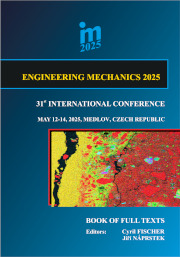Proceedings Vol. 31 (2025)

ENGINEERING MECHANICS 2025
May 12 – 14, 2025, Medlov, Czech Republic
Copyright © 2025 Institute of Theoretical and Applied Mechanics of the Czech Academy of Sciences, Prague
ISBN 978-80-86246-99-4 (electronic)
ISSN 1805-8248 (printed)
ISSN 1805-8256 (electronic)
All papers scientific commitee
Conference Proceedings
The Engineering Mechanics 2025 conference served as an important international forum for presenting and discussing recent developments across the diverse field of mechanics. Its objective was to bring together researchers, engineers, industry practitioners, and postgraduate scholars to share knowledge, exchange ideas, and address pressing scientific and engineering challenges, particularly those that reflect or promote cooperation between Czech research institutions and industry.
The 2025 conference was held in the scenic surroundings of the Žďár Highlands, at Hotel Medlov (close to Fryšava pod Žákovou horou), continuing a long-standing tradition of collaboration between academia and applied practice.
The program featured contributions spanning biomechanics, dynamics, fluid mechanics, fracture mechanics, kinematics, mechanics of solids, mechatronics, reliability of structures, technological processes, and thermomechanics. These presentations reflected ongoing research and active development and, by their very nature, provoked discussion, encouraged interdisciplinary exchange, and inspired new scientific partnerships. Together, they represent a vibrant and essential form of knowledge sharing — one that complements and enriches traditional academic publishing.
- Preface
- Chapter 1: Keynote Lectures
- Chapter 2: Advances in Biomechanics
- Chapter 3: Advances in Dynamics
- Chapter 4: Fluid Mechanics and Computational Fluid Dynamics
- Chapter 5: Advances in Fracture Mechanics
- Chapter 7: Mechatronics
- Chapter 8: Reliability of Structures
- Chapter 6: Mechanics of Solids – Modeling, Materials, and Applications
- Chapter 9: Technological Processes and Thermomechanics
All contributions are published under the Creative Commons Attribution 4.0 International License (CC BY 4.0). The copyright remains with the authors. The texts are publicly accessible, and any reuse must include appropriate credit to the original source as required by the license.
All papers were reviewed by members of the scientific committee.

 Powered by
Imce 3.20 © 2023, Pavel Formánek, Institute of Thermomechanics AS CR, v.v.i. [generated: 0.0114s]
Powered by
Imce 3.20 © 2023, Pavel Formánek, Institute of Thermomechanics AS CR, v.v.i. [generated: 0.0114s]